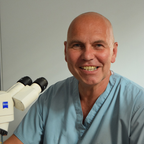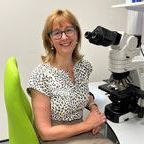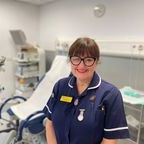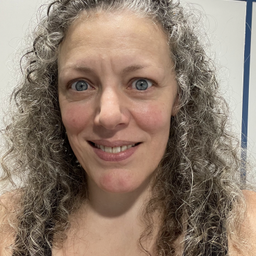Cytopathology
Overcoming challenges to passing cervical cytology exams
Cytopathology
Overcoming challenges to passing cervical cytology exams
9am – 9.30am BST, 26 September 2023 ‐ 30 mins
Cytopathology
Speakers

Overcoming challenges to passing diagnostic cytology exams
Cytopathology
Overcoming challenges to passing diagnostic cytology exams
9.30am – 10am BST, 26 September 2023 ‐ 30 mins
Cytopathology
Speakers
Tracey Stevenson CSci FIBMS
Consultant Biomedical Scientist in Cytology, Royal Devon & Exeter NHS Foundation Trust
IVF cycle
Cytopathology
IVF cycle
10.30am – 11am BST, 26 September 2023 ‐ 30 mins
Cytopathology
Abstract
A journey through an IVF cycle looking at the sequential steps involved, sperm preparation methods, a brief overview of embryo grading and showcasing the input from Reproductive Scientists in the different stages of treatment for our patients.
Speakers
Annette Lloyd
Principal Clinical Embryologist and Scheme Organiser (UK NEQAS), Dept. of Reproductive Medicine Old St. Mary's Hospital and UK National External Quality Assessment Service for Reproductive Science (NEQAS)
Genetics and the Fertility Clinic
Cytopathology
Genetics and the Fertility Clinic
11am – 11.30am BST, 26 September 2023 ‐ 30 mins
Cytopathology
Learning outcomes
Andrology under Laboratory Medicine will often involve a multi-disciplinary approach and the patient may have to undergo further tests. These tests are often (but not exclusively) undertaken by nurses and consultants and can impact the direction and management of the couple. Some of these tests will include Cytogenetics.
The results of these tests can dramatically impact the couple, the man and subsequent management. The knowledge and understanding of these tests is often discussed from a clinical perspective but Biomedical Scientists may not be as fully involved and therefore would benefit from a wider understanding of male specific genetic influences.
Speakers
Teratozoospermia Index (TZI): The debate
Cytopathology
Teratozoospermia Index (TZI): The debate
11.30am – 12pm BST, 26 September 2023 ‐ 30 mins
Cytopathology
Abstract
Semen analyses is essential to understand male factor infertility and to allow planning for treatment options. Absence or low numbers of viable sperm become a challenge and to define whether obstruction removal surgery is needed or whether it would be possible to possible to boost sperm numbers if hormonally related problems exist.
Semen diagnostic analyses is used to define which treatment modality, timed sexual intercourse, intrauterine insemination (IUI) or in vitro fertilisation (IVF) or if intracytoplasmic sperm injection (ICSI) is needed. Despite all efforts, around 70% of women remain barren after treatment and little understanding exists especially on male factor which forms almost half the problem. Poor to very poor sperm quality relating to multiple factors such as counts, motility and morphology are increasingly associated with declining embryo quality, pregnancy outcomes and recurrent miscarriage. Asthenozoospermia/asthenospermia) is related to reduced sperm motility, whereas teratozoospermia refers to morphology condition. For the first time the field of diagnostic andrology has a chance to make substantial male factor contribution towards the knowledge of poor success rates and have available a numeral encompassed in `teratozoospermia index’ (TZI). The TZI has a maximum of four defects per abnormal spermatozoon: one each for head, midpiece and principal piece, and one for excess residual cytoplasm. The TZI is the sum of all abnormalities divided by the sum of abnormal spermatozoa, thus always giving a result between 1.00 and 4.00.
Ordinary semen analyses so far have had limited predictive value, but TZI will form a meaningful and constructive contribution to reproductive medicine, allowing for less invasive and less commercially driven and unnecessary expensive ICSI treatments. To derive the TZI numeral does not require significantly more investment other than performing a simple calculation to reach this index numeral, while conforming to WHO standards. There are sufficient parallels between poor sperm quality and DNA damage and recurrent miscarriage for instance, and morphology deficit evidence is beginning to emerge, adding TZI potential substantially to diagnostic andrology analyses as well as in providing clinical steers.
The Teratozoospermia Index (TZI) is a recent addition to WHO guidelines. The interpretation of the guidelines and whether laboratories should/should not undertake this test is contentious and may cause issues for many services.
This debate will involve two speakers: one for and one against TZI implementation. This will give attendees a rounded review of this area and support their decisions in undertaking this examination.
The Teratozoospermia Index (TZI) is a recent addition to WHO guidelines. The interpretation of the guidelines and whether laboratories should/should not undertake this test is contentious and may cause issues for many services. This debate will involve two speakers: one for and one against TZI implementation.
Sperm morphology assessment is part of a basic semen analysis. Accurate assessment of the percentage of normal-shaped sperm can help in diagnosing male factor infertility and in signposting to the most effective assisted conception therapy if needed.
Beyond classifying whether or not a sperm shape is normal, the introduction of the teratozoospermia index (TZI) requires us to now look at each sperm in far more detail. We are asked to assess the percentage of specific abnormalities such as head shape (is it too thin or amorphous?), midpiece (is it slightly asymmetric?) and tail (is it a little too short?). However, such assessments require additional time-consuming work for the biomedical andrologist and is it really of any clinical relevance?
Most sperm shape defects are easy to detect by the basic analysis without this extra work. Examples include globozoospermia, macrocephaly, decapitated sperm syndrome and fibrous sheath dysplasia, all of which are simply diagnosed, as often the vast majority of sperm affected.
Learning outcomes
The contra debate will put forward various points to try to convince you that the TZI is of little benefit to those of us working in reproductive medicine. With biomedical scientists already pushed to the brink, why add to their burden, if it doesn’t change the patient pathway?
This will give attendees a rounded review of this area and support their decisions in undertaking this examination.
The presentation will also:
- Look at how the teratozoospermia index (TZI) is performed.
- Consider the subjective nature of assessing sperm morphology.
- Encourage critical thinking before introducing further biomedical testing for andrology diagnostics.
Speakers

Dr Gulum Bahadur
Consultant Clinical Andrologist, Reproductive Medicine Unit, North Middlesex University Hospital

Head & Neck Clinic – Sonographer’s perspective
Cytopathology
Head & Neck Clinic – Sonographer’s perspective
9am – 9.30am BST, 27 September 2023 ‐ 30 mins
Cytopathology
Abstract
Head and Neck cancers account for approximately 3% of new cancer incidence in the United Kingdom (UK). The use of ultrasound guided fine needle aspirations within head and neck ultrasound, has become a vital resource for cancer diagnosis. Historically, it was common for head and neck patients requiring a fine needle aspiration, to have an insufficient tissue sample from their initial examination, leading to patient re-call for repeat investigation. Subsequently, this negatively impacted upon the patient pathway by delaying cancer diagnosis and treatment.
The utilisation of Rapid on-site Evaluation (ROSE) has proven to transform the diagnostic pathway by negating the need for repeat examinations and therefore improving the rate at which patients are diagnosed and treated.
This presentation focuses on the achievements that have been accomplished through great collaborative working between radiology and cytology within head and neck and the consequent patient benefits. It includes a summary of how the ROSE service has grown at Royal Cornwall Hospital to include the Cornwall ROSE research pilot and the values this has brought to the population.
Case studies will be included as examples of where ROSE has been paramount to a swift diagnosis.
Additionally, the advantages and disadvantages of working with ROSE will be discussed from a sonographer's viewpoint, highlighting the potential pitfalls.
References
1. Head and neck cancers statistics | Cancer Research UK [Internet]. [cited 2023 May 26]. Available from: https://www.cancerresearchuk.org/health-professional/cancer-statistics/statistics-by-cancer-type/head-and-neck-cancers#heading-Zero
2. Breeze J, Poller DN, Gibson D, Tilley EA, Cooke L, Soar E, et al. Rapid on-site assessment of specimens by biomedical scientists improves the quality of head and neck fine needle aspiration cytology. Cytopathology. 2013 Oct;n/a-n/a.
3. Medina Chamorro FM, Calle JA, Stein JE, Merchancano L, Mendoza Briñez AM, Pulido Wilches AA. Experience of the Implementation of Rapid On-Site Evaluation in Ultrasound-Guided Fine-Needle Aspiration Biopsy of Thyroid Nodules. Curr Probl Diagn Radiol. 2018 Jul;47(4):220–4.
4. Aly AK, Ali MA, Sharma A, Gubbels MA, Zhao X, Ahmed A, et al. Rapid On-site Evaluation (ROSE) for Fine Needle Aspiration of Thyroid: Is It Helpful? SciMed J. 2021 Mar 1;3(1):1–7.
Learning outcomes
Delegates attending this presentation will gain an understanding of:
- The perspective from the sonographer’s role within the clinical setting
- Collaborative working (Radiology and cytology)
- Advancing practice/innovation
- The patient experience.
Speakers

Sarah Martyn
Head and Neck Consultant Sonographer , Royal Cornwall Hospitals NHS Trust
Pathology of Head & Neck – Histology & Cytology
Cytopathology
Pathology of Head & Neck – Histology & Cytology
9.30am – 10am BST, 27 September 2023 ‐ 30 mins
Cytopathology
Abstract
The aim for this session is to carry on with the patient’s journey to final diagnosis. This presentation will discuss how the valuable material obtained from ROSE clinics are utilised in making a diagnosis and provide prognostic/treatment related information.
With the use of a number of examples, this presentation will illustrate how cytology impacts on patient’s management pathway, and how a standardised reporting system could be useful in unifying diagnostic pathways and performing future work on audit and quality improvement.
Finally, the strengths and limitations of head and neck cytology from the perceptive of a histo/cytopathologist will be discussed
Learning outcomes
Delegates attending this presentation will gain an understanding of:
- The role of a histo/cytopathologist in the diagnostic process
- The use of a standardised reporting system in head and neck (e.g. salivary gland) cytology reporting
- How cytology influence patient management
- The potential limitations of head and neck cytology.
Speakers
Dr Kris Hoi Ki Leung
Consultant Pathologist, Royal Devon University Healthcare NHS Foundation Trust
Specialist portfolios: Updated, flexible and achievable
Cytopathology
Specialist portfolios: Updated, flexible and achievable
10.30am – 11am BST, 27 September 2023 ‐ 30 mins
Cytopathology
Learning outcomes
- Overview of the new online specialist diploma qualifications
- Awareness of the flexibility of the online system
- Additions to the specialist options (ROSE)
Speakers

New ROSE specialist module
Cytopathology
New ROSE specialist module
11am – 11.30am BST, 27 September 2023 ‐ 30 mins
Cytopathology
Abstract
The requirement of extensive and complex testing on cytology samples is widely and routinely recognised. ROSE performed by scientists in the clinical setting provides a standardised, clinically effective, reproducible methodology for a variety of anatomical sites, some of which cytology is the only modality for sampling.
Real-time adequacy assessment eliminates the need for more invasive or repeat procedures by ensuring sufficient cell yield is obtained to conduct all the tests required for ancillary and molecular testing. This streamlines the patient pathway by reducing the referral to treatment time and reduces waiting list pressures, resulting in cost reduction for healthcare trusts and improved patient care and outcomes.
The presentation will explore the new IBMS ROSE qualification with the aim to inspire scientists to become skilled in ROSE.
Learning outcomes
Delegates will gain:
- An awareness of the new IBMS specialist portfolio for rapid on-site evaluation
- Knowledge of the requirements and training needs
- Understand the benefits of completing the qualification
- Information on potential future funding options
Speakers

Leonie Wheeldon
Consultant Biomedical Scientist - Diagnostic Cytopathology, Royal Cornwall Hospitals NHS Trust
Changing and expanding roles in Cellular Pathology
Cytopathology
Changing and expanding roles in Cellular Pathology
11.30am – 12pm BST, 27 September 2023 ‐ 30 mins
Cytopathology
Learning outcomes
Delegates will understand:
- How to adapt to the loss of cervical cytology as a Biomedical Scientist
- Changing & Expanding roles
- The highs and lows of fitting in a different team
Speakers
Paul Hawkins
Specialist Biomedical Scientist, Royal Devon University Healthcare NHS Foundation Trust
Use of cell blocks in Cytology – Technical aspects
Cytopathology
Use of cell blocks in Cytology – Technical aspects
2pm – 2.30pm BST, 27 September 2023 ‐ 30 mins
Cytopathology
Abstract
The aim of this presentation is to explain the growing importance of the use of cytopathology cell blocks in the diagnostic process and how this has evolved over recent years. In the past they were used as an 'extra' to the traditional Papanicolaou and Romanowsky stains whereas now they have an essential role in providing material for ancillary testing - immunocytochemistry and molecular studies.
The variety of methods of cell block preparation will be covered and why it is important that a department choses what method, or methods, are best suited to what is required from the finished result.
Learning outcomes
Delegates will gain knowledge on the:
- Preparation of different cell blocks from cytology samples
- Use of Cell blocks for ICC
- Pros and cons and considerations
Speakers
Anna Patterson
UKNEQAS CPT Diagnostic Cytology Scheme Coordinator , UK NEQAS for Cellular Pathology Technique (CPT)
The cellular pathology of clots and cell blocks
Cytopathology
The cellular pathology of clots and cell blocks
2.30pm – 3pm BST, 27 September 2023 ‐ 30 mins
Cytopathology
Learning outcomes
- A focus on the morphology / IHC and molecular uses and issues of clot and cell block preparations
- Assessing whether you have representative cells for reliable IHC and molecular analysis
- Clot and cell block cellularity and comparison with direct, cytospin or LBC preparations
Speakers

Dr Anthony Maddox
Consultant Cellular Pathologist, Lead for diagnostic cytopathology and respiratory pathology, West Hertfordshire Teaching Hospitals NHS Trust
UKNEQAS CPT Diagnostic Cytopathology Cell Block Scheme
Cytopathology
UKNEQAS CPT Diagnostic Cytopathology Cell Block Scheme
3pm – 3.30pm BST, 27 September 2023 ‐ 30 mins
Cytopathology
Abstract
Cell blocks from Diagnostic Cytopathology (DC) samples have always had value in the diagnostic process as a complement to the traditional cytology stains – Papanicolaou and Romanowsky. It has become more important to provide material for Immunocytochemistry to refine malignant diagnosis, and more recently, the use of molecular testing to aid in the choice of tailored chemotherapy regimens. If this information can be obtained from DC samples, which are less invasive than biopsy samples, the patient will benefit.
External Quality Assurance of cell block preparations has up to now been covered by the Tissue Diagnostic scheme. However, this is not entirely appropriate as cytopathology departments use a variety of cell block preparation methods and fixatives. The increase in number of cell block Haematoxylin and Eosin slides submitted to our evaluation service and the queries we receive regarding advice on best preparation methods suggested there was a need for a separate scheme for evaluation of cell blocks. A circulated survey indicated that there is a need for such a scheme. In response to this we performed 2 pilot studies which were well supported and successful, leading to the launch of the live scheme in April 2023.
This presentation covers the development of the scheme and the results of the 2 pilots. As an ongoing process the scheme will be able to garner information about ‘best methods’ and this can be passed on to laboratories experiencing problems and improve standards. UKNEQAS CPT is not just a ‘tick box’ service for UKAS, it is also an advisory service which aims to improve diagnostic practices.
Learning outcomes
Delegates will:
- Understand the requirement for EQA for cytology cell blocks
- Be updated on results of pilots so far
- Learn about the challenges and changes to the scheme as a result of the pilots
Speakers

Helen Naylor
Technical Specialist and Biomedical Scientist , UK NEQAS for Cellular Pathology Technique (CPT)
Whats new in Diagnostic Cytology (Reporting systems; biomarker testing)
Cytopathology
Whats new in Diagnostic Cytology (Reporting systems; biomarker testing)
4pm – 4.30pm BST, 27 September 2023 ‐ 30 mins
Cytopathology
Speakers
Dr Graham Watson
A 360° appraisal of careers in cytopathology
Cytopathology
A 360° appraisal of careers in cytopathology
4.30pm – 5pm BST, 27 September 2023 ‐ 30 mins
Cytopathology
Abstract
This presentation will draw upon the experience and knowledge of the presenters to give delegates information on:
- A consultants perspective on biomedical scientist reporting
- First year in post after the ASD in diagnostic cytology
- Histology reporting – the reality of the day job
- Roles in Quality and Training
- Cytology in social media – Friend or Foe
Speakers
Tracey Stevenson CSci FIBMS
Consultant Biomedical Scientist in Cytology, Royal Devon & Exeter NHS Foundation Trust

Dr Anthony Maddox
Consultant Cellular Pathologist, Lead for diagnostic cytopathology and respiratory pathology, West Hertfordshire Teaching Hospitals NHS Trust

Leonie Wheeldon
Consultant Biomedical Scientist - Diagnostic Cytopathology, Royal Cornwall Hospitals NHS Trust
New Advanced Specialist Diploma in Histopathology Reporting Qualifications
Cytopathology
New Advanced Specialist Diploma in Histopathology Reporting Qualifications
9am – 9.30am BST, 28 September 2023 ‐ 30 mins
Cytopathology
Abstract
The session will provide an overview of the Histopathology Reporting qualifications outlining the success so far and then will focus on the two new limited scope Reporting qualifications. It will provide guidance on the eligibility criteria for these qualifications, the portfolio requirements and the support needed by candidates from colleagues in order to undertake the qualification.
Speakers

Digital cervical cytology: The Monklands experience
Cytopathology
Digital cervical cytology: The Monklands experience
9.30am – 10am BST, 28 September 2023 ‐ 30 mins
Cytopathology
Learning outcomes
This presentation will describe the experience of the Monklands laboratory with the Hologic Genius digital cytology system.
Delegates will learn:
- How the Digital system works and what advantages it can bring to cervical screening
- Data on efficiency and capacity gains
- Hints and tips for labs considering a move to digital cytology
- How digital cytology fits into laboratory workflow.
Speakers

Professor Allan Wilson CSci, FIBMS, FRCPath (Hon), MBA
Consultant Biomedical Scientist, IBMS Past President, Monklands University Hospital, NHS Lanarkshire
Perspectives on the Borderline Endocervical Cell Classification
Cytopathology
Perspectives on the Borderline Endocervical Cell Classification
10.30am – 11am BST, 28 September 2023 ‐ 30 mins
Cytopathology
Abstract
The term borderline nuclear change was introduced to the cervical screening programme in 1986 to cover a variety of changes ranging from reactive to just short of dyskaryotic. In 2008 the classification of borderline nuclear change was revised to distinguish between the different circumstances in which the term was being applied, including those found in endocervical glandular cells. Furthermore it was suggested that rather than requesting a repeat test, as was the practice at the time, referral for colposcopic assessment be recommended in recognition of a small number of studies indicting a high proportion of grade CIN and/or CGIN outcomes in these cases.
To date borderline nuclear changes in endocervical glandular cells remains a challenging aspect of cervical cytology screening due to the rarity of the condition and the limited availability of published data, particularly post primary HPV implementation.
Learning outcomes
This presentation will cover:
- Difficulties associated with interpretation of endocervical glandular cells
- Outcome data, including PPV
- MDT case discussion
Speakers

Benign glandular histology as potential for BLEC
Cytopathology
Benign glandular histology as potential for BLEC
11am – 11.30am BST, 28 September 2023 ‐ 30 mins
Cytopathology
Speakers
Update on endocervical adencarcinomas
Cytopathology
Update on endocervical adencarcinomas
11.30am – 12pm BST, 28 September 2023 ‐ 30 mins
Cytopathology
Speakers
HPV Entrapment Syndrome: a difficult problem in the Triage Pathway
Cytopathology
HPV Entrapment Syndrome: a difficult problem in the Triage Pathway
1.30pm – 2.30pm BST, 28 September 2023 ‐ 1 hour
Cytopathology
Abstract
The management of low grade smear abnormalities has posed problems for over 30 years and these will be described in some detail leading on to the most recent difficulty caused by the HPV Triage Pathway in the Cervical Screening Programme. The concept of HPV Entrapment Syndrome will be introduced and management strategies to deal with this difficult problem will be discussed. As well as explaining what HPV Entrapment means, there will be a detailed case presentation of a typical patient followed by a review of some of the numerous smear abnormalities that prevented her from leaving the Triage Programme.
Speakers
Michael Jones
Consultant Gynaecologist, St George's Hospital, University of London and Darent Valley Hospital, Dartford and Gravesend NHS Trust
Role of MDT – Clinical Perspective; Colposcopy for patients with learning difficulties
Cytopathology
Role of MDT – Clinical Perspective; Colposcopy for patients with learning difficulties
2.30pm – 3pm BST, 28 September 2023 ‐ 30 mins
Cytopathology
Speakers

Jill Fozzard
Clinical Nurse Specialist, Newcastle upon Tyne Hospitals NHS Foundation Trust

Jilly Goodfellow
Clinical Nurse Specialist , Newcastle upon Tyne Hospitals NHS Foundation Trust
Colposcopy for patients with learning difficulties
Cytopathology
Colposcopy for patients with learning difficulties
3pm – 3.30pm BST, 28 September 2023 ‐ 30 mins
Cytopathology
Abstract
From earlier work that I had done in a sexual health setting, I identified that there were barriers for women with a learning disability attending for cervical screening. I was invited to talk to a group of women about cervical screening as part of an initiative called 'The Josephine Project'. Josephine is an anatomically correct cloth doll which is used for health promotion purposes - she has body parts which can be detached and has a 'space' in her head where women can put ideas on paper. Within a mock up clinic, Josephine, along with her friends (the women in the group), attended the sexual health clinic to have a cervical sample taken. This work was very successful and led to several women taking up the offer of screening.
Myself and Jilly realised that as Nurse Colposcopists this work could be translated into a secondary care setting and so Josephine was invited to the colposcopy clinic following an abnormal cervical screening result. This presentation discusses some of the barriers for the women with a learning disability and how 'Josephine' came to life to help and support some of those women.
Speakers

Jill Fozzard
Clinical Nurse Specialist, Newcastle upon Tyne Hospitals NHS Foundation Trust

Jilly Goodfellow
Clinical Nurse Specialist , Newcastle upon Tyne Hospitals NHS Foundation Trust













